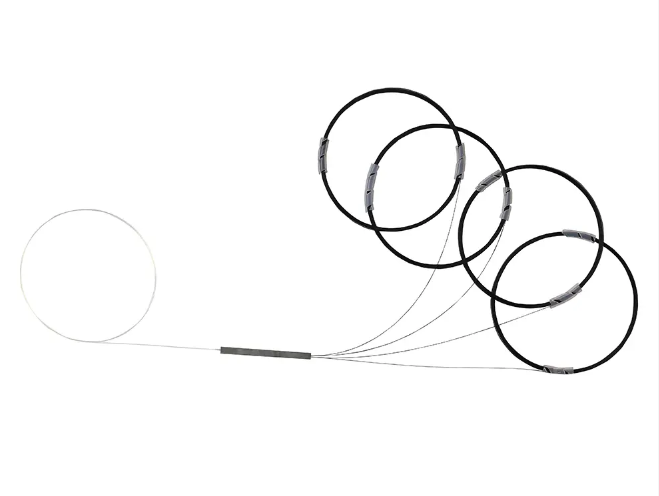Exploring the Advantages of Bare Fiber PLC Splitters in Passive Optical Networks

Bare Fiber PLC Splitters Overview
Understanding Passive Optical Networks
Passive optical networks are a crucial part of telecommunication technology, facilitating the efficient distribution of optical signals. This network architecture consists of various key components, including optical splitters, ONUs (Optical Network Units), and OLTs (Optical Line Terminals). Among these components, bare fiber PLC splitters play a vital role in enabling the seamless distribution of optical signals within passive optical networks.
Key Components of Passive Optical Networks
Optical splitters, such as bare fiber PLC splitters, are essential for dividing and distributing optical signals efficiently.
ONUs receive the signals and communicate with end-user devices, while OLTs manage the overall network traffic.
Optical Signal Distribution Role
Efficient signal splitting is made possible by bare fiber PLC splitters, ensuring that the distributed optical signals reach their intended destinations without loss or interference. Their integration within passive optical networks is fundamental to the effective functioning of telecommunication technology.
Importance in Telecommunication Technology
Bare fiber PLC splitters contribute significantly to enhancing the overall efficiency of fiber optic communication systems. By enabling seamless signal distribution, they play a critical role in ensuring reliable and high-performance telecommunications infrastructure.
Telecommunication Technology Integration
The incorporation of bare fiber PLC splitters into telecommunication technology is pivotal for managing network signal distribution effectively. These devices form an integral part of the infrastructure responsible for delivering high-speed internet and other telecommunications services to end-users.
Understanding Passive Optical Networks
Passive Optical Networks in Telecommunications
Passive optical networks (PONs) are an indispensable element of modern telecommunication technology. They form the backbone of efficient signal distribution, ensuring that optical signals are transmitted seamlessly within telecommunications infrastructure. The implementation of passive optical systems has revolutionized the way data and voice signals are distributed, providing a cost-effective and reliable solution for network operators.
One of the key advantages of passive optical components is their ability to transmit data over long distances without significant loss or degradation. This makes them ideal for serving a large number of end-users, whether in residential, business, or industrial settings. Additionally, passive optical systems require minimal maintenance, reducing operational costs and ensuring uninterrupted service delivery.
The deployment of passive optical components in telecommunications has significantly enhanced network reliability and performance. By leveraging the inherent benefits of passive optical technology, network operators can meet the increasing demands for high-speed internet and other advanced services while maintaining a robust and efficient infrastructure.
Key Components of Passive Optical Networks
The fundamental elements of passive optical networks include passive optical splitters, ONUs (Optical Network Units), and OLTs (Optical Line Terminals). These components work together to facilitate the seamless transmission and reception of optical signals across the network. Among these components, passive optical splitters play a critical role in dividing and directing the signals efficiently to their intended destinations.
Optical Signal Distribution Role
Efficient Signal Splitting
In the realm of optical signal distribution, bare fiber PLC splitters excel in enabling efficient signal splitting in telecommunications networks. These advanced devices are designed to divide incoming optical signals into multiple outputs with minimal loss, ensuring that the transmitted data reaches its intended destinations without degradation. By incorporating cutting-edge signal splitting technology, bare fiber PLC splitters contribute to the seamless distribution of optical signals in telecommunications infrastructure.
The efficiency of signal splitting technology is paramount in maintaining the integrity and reliability of optical networks. Bare fiber PLC splitters play a pivotal role in achieving this efficiency by accurately dividing the optical signals while preserving their quality. This capability is essential for meeting the increasing demands for high-speed internet and other data services, thereby enhancing the overall performance of telecommunication technology.
Importance in Telecommunication Technology
Within telecommunication technology, bare fiber PLC splitters hold significant importance as integral components of optical network infrastructure. Their role in managing optical signal distribution is instrumental to the effective functioning of various network elements, including ONUs and OLTs. By contributing to the overall efficiency of fibre optic communication systems, these splitters ensure that data transmission occurs seamlessly across the network, meeting the diverse needs of end-users.
Telecommunication Technology Integration
Incorporating Fiber Optic Technology
In the realm of telecommunication technology, bare fiber PLC splitters seamlessly incorporate fibre optic technology to facilitate efficient signal distribution within optical networks. These advanced splitters are designed to harness the capabilities of optical fibre technology for managing network signal flow effectively. By integrating cutting-edge fibre optic technology, bare fiber PLC splitters play a crucial role in optimising the performance and reliability of telecommunications infrastructure.
The incorporation of fibre optic technology into bare fiber PLC splitters is fundamental to their function as vital components of network signal management in telecommunication technology. Their seamless integration ensures that optical signals are efficiently divided and directed across the network, contributing to the overall efficiency and effectiveness of optical network infrastructure.
Role in Optical Network Infrastructure
Within optical network infrastructure, bare fiber PLC splitters assume a pivotal role in facilitating the seamless distribution of optical signals. Their installation is integral to ensuring the effective functioning of various components within the network, including ONUs and OLTs. By optimising signal distribution, these splitters contribute significantly to maintaining the reliability and performance of optical communication systems.
Efficiency and Advantages
Advantages of Bare Fiber PLC Splitters
Bare fiber PLC splitters offer numerous advantages that significantly contribute to the overall efficiency of telecommunication technology. These advanced devices play a crucial role in optimising the performance and reliability of telecom systems by facilitating seamless optical signal distribution. One key advantage is their ability to efficiently divide incoming optical signals into multiple outputs, ensuring that the transmitted data reaches its intended destinations without loss or degradation. This capability enhances the overall effectiveness of telecom technology infrastructure, meeting the diverse needs of end-users while maintaining high-quality service delivery.
Another notable advantage of bare fiber PLC splitters is their integral role in enhancing network efficiency within telecommunication technology. The installation of these splitters is essential for the effective functioning of optical network components, including ONUs and OLTs. By optimising signal distribution, bare fiber PLC splitters contribute significantly to maintaining the reliability and performance of telecom systems, thereby enhancing network efficiency and meeting the increasing demands for high-speed internet and other advanced services.
Maximizing Network Efficiency
Achieving Optimal Network Performance
In the realm of telecommunications, achieving optimal network performance is a fundamental goal that relies on the seamless integration of advanced technologies. Fiber optic splitters play a pivotal role in maximising network efficiency by facilitating the smooth and efficient distribution of optical signals. Their ability to divide incoming signals accurately and direct them to their intended destinations ensures that data transmission occurs without loss or degradation. This contributes significantly to the overall effectiveness of telecommunication technology, meeting the diverse needs of end-users while maintaining high-quality service delivery.
Key Role in Network Optimization
Bare fiber PLC splitters contribute to the overall efficiency of fibre optic communication systems
They ensure reliable and high-performance telecommunications infrastructure
The seamless distribution of optical signals is achieved through the use of bare fiber PLC splitters
See Also
Discovering the Advantages of the 960 Core Fiber Optic Splice Closure
Attaining Optimal Performance and Economical Fiber Optic Connection
Advantages of ADSS Fibre Optic Cables for Overhead Power Lines
The Function of Fibre Optic Cables in Belowground Setups
Investigating the Advantages of IP67 Watertight FTTX Solutions


